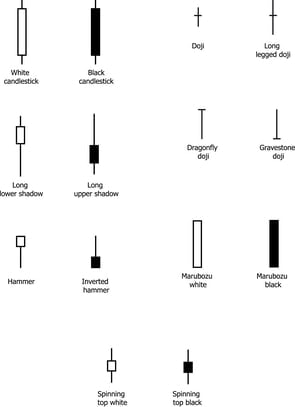Japanese candlesticks come in a variety of shapes and sizes, and when you group these varying candlesticks together, you create useful patterns. Once you’re able to recognize, understand, and utilize these patterns, you can find success through candlestick charts. Although numerous candlestick patterns exist and all traders have their personal favorites, today we’re going to run through some of the most beloved and effective candlestick patterns. You can’t go wrong with these five patterns, especially if you’re able to combine them with other indicators. They are, quite simply, some of the best candlestick patterns around.
Best Candlestick Patterns

- Doji. The doji is often one of the first candlestick patterns that traders learn. It’s easy to identify because it resembles a plus sign, a cross, or an inverted cross. A doji conveys that the market is currently undecided. A turning point should be right around the corner.
- Engulfing. An engulfing pattern features two candles, the first short in body and the second long in body. They are also opposite colors. The second candle is said to “engulf” the first because the top of its body is higher than the first candle and its bottom is lower.
- Hammer. A hammer pattern forms after a decline in the market. This bullish reversal pattern has a long lower shadow (it must be at least twice as long as the body) and a small or nonexistent upper shadow.
- Evening Star. The evening star is a three-day pattern that occurs after an uptrend. It is formed when the following candles align: the first day has a long white body, the second day is short and high (possibly a doji), and the third day closes before the midpoint of the first day. This pattern conveys that there are rough waters (i.e., low stock prices) ahead.
- Harami. The harami indicates that previous momentum has come to an end. It begins with a long-bodied candle located near the bottom of the range, and it continues on the second day with a short-bodied candle closing up for the day. The candles must be different in color, and the first candle must be the same color as the preceding trend. Also, the first candle must surpass the second candle on the top and bottom. Many traders confuse the harami with the engulfing pattern, because they are similar in shape and seem to mirror each other.
Although there are many other handy and reliable indicators to keep an eye out for, these are some of the best candlesticks patterns around. So if you’re just starting out in the world of Japanese candlesticks, be sure that you’re able to recognize and appropriately react to these five patterns at the very least. They’re dependable, effective, and very useful. Good luck!
If you’re interested in mastering some simple but effective swing trading strategies, check out Hit & Run Candlesticks. Our methods are simple, yet powerful. We look for stocks positioned to make an unusually large percentage move, using high percentage profit patterns as well as powerful Japanese Candlesticks. Click here to sign up for a FREE 2-week trial membership.





Comments are closed.